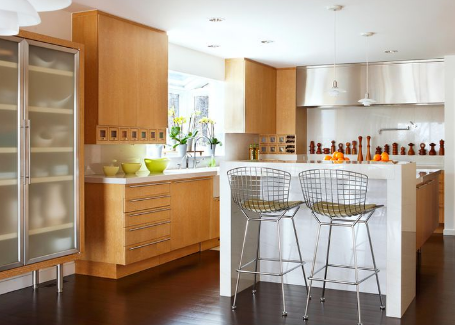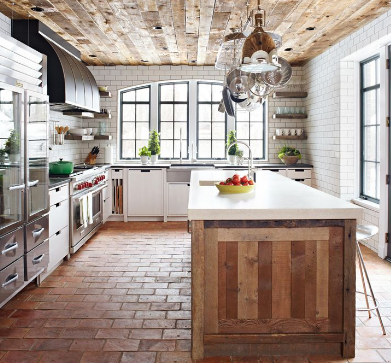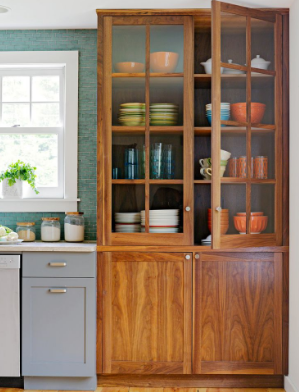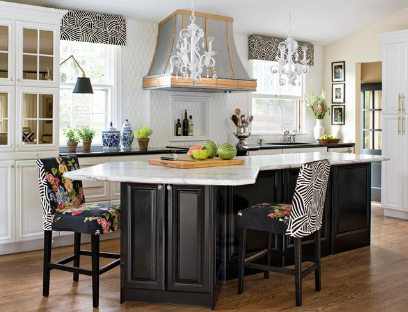
Enhance Your Space with Beautiful and Functional Curtains
February 2, 2025
Living Room Wallpaper Ideas That Show Off Design Style
February 5, 2025Wooden cabinetry is a classic feature of any kitchen. When dyed or kept natural, wood cabinetry can be paired with almost any décor style, making it a popular cabinet choice for homeowners. Although most cabinets are made of hardwood, these materials are often applied as veneers on substrates such as plywood to keep costs down. Wood alternatives, such as laminate and hot foil, offer another cabinet material option that provides the appearance of hardwood at a lower cost.
Before choosing wooden cabinets, know that they can easily deform with changes in water content. That’s why it’s so important to surface treat all sides of the wood before it leaves the factory. Unfinished cabinets should be completed on-site as soon as possible to prevent deformation. In areas with high humidity, veneer cabinets are more stable than solid wood cabinets. Read on to learn more about the various cabinet types, including wood cabinet varieties and alternatives like laminated kitchen cabinets.
Types of Wooden Cabinets
The color and style of wooden cabinets depend on the material. Options include oak, maple, hickory, cherry, birch, ash, and pine. Check out the wood cabinet guide below to see what makes each material type different.
1. Red Oak Cabinetry

Red oak is strong, durable, and relatively inexpensive for wooden kitchen cabinets. It is available in a variety of styles and finishes with a distinct textured pattern and is most commonly used in traditional cabinet styles. This wood can be used for inventory, semi-custom, and custom cabinetry.
2. White Oak Cabinetry

White oak is just as durable as red oak and is stronger. White oak has a more golden hue with a more subtle grain and is often quarter-sawn into custom cabinetry, especially for arts and crafts or period looks. Generally, white oak is only available as a customization option.
3. Hard Maple Cabinetry

Hard maple is a fine-grained, light-colored wood that is slightly more expensive than oak but less dense. Maple is a popular choice for semi-custom and custom cabinetry, which can be stained, but is often available in a clear or natural finish for a light, modern look.
4. Hickory Cabinets

Hickory wood seen on the island of the kitchen is lighter than oak, but the grain pattern and intensity are similar. This cream-colored, yellowish wood can be stained; However, like maple, its golden hue is often complemented by a clear or natural finish. Perfect for rustic farmhouse-style kitchens, hickory is a rare choice for custom and semi-custom cabinetry.
5. Cherry Wood Cabinets

Cherry wood kitchen cabinets are hard enough to withstand impacts and damage. When used in certain traditional styles, cherry wood appears elegant and formal, and the versatility of its design can also give the kitchen a modern personality. Smooth, fine-grained wood is red to reddish-brown in color and darkens over time. For color uniformity, this cabinet material is often dyed.
6. Birch Cabinets

Birch is a durable, fine-grained wood with a slightly darker color than maple. It needs a good finish and can be camouflaged as more expensive wood. When stained, it can achieve a good “faux” cherry or maple appearance. Birch is prone to some irregular colors and is a relatively inexpensive wood option in both stock and semi-custom lines.
7. Ash Cabinetry

Ash wood is similar in strength and durability to oak, but with a lighter color and more pronounced shape. This straight-grained wood takes on a modern character after a clear or natural treatment. Its availability is limited to semi-custom lines and is more common for custom kitchen cabinet work.
8. Pine Cabinets
Pine is the only softwood tree species commonly used in cupboards, and it is more prone to dents than hardwood. This yellowish wood appears on the islands and ceilings of kitchens, can be stained, and often comes with knots that are used to emphasize tradition and rustic styles. Eastern White Pine and Western White Pine appear in select semi-custom strains.
Wooden Cabinet Features to Consider
When deciding between multiple options, consider these factors to help you choose the best cabinet material.
- Texture: Except in very high-end cases, veneer cabinets may offer a better texture match than solid wood cabinets.
- Color: You don’t always like the natural color of wood. For example, a colorant can replicate the color of maple on a birch base. Painting wooden cabinets is also an option.
- Construction: Wooden cabinet drawers can be constructed using dowels or notches and dovetails. Drawers with dovetails usually last longer, but consume more wood when producing, so they are more expensive.

Wooden Cabinet Cost Guide
Wood or wood and plywood cabinetry start at around $100 per foot, especially in the inventory and semi-custom segments. For the rarest woods, custom designs, etc., the cost can rise to more than $300 per foot. Cabinets that are not solid wood or wood veneer are usually made of laminate or hot foil, both of which are applied to the substrate. Laminates and hot foils come in a variety of colors and patterns, including some that mimic wood.
Types of Wood Substitutes
Laminates are made of three resin-saturated layers: a paper base, a printing and coloring layer (which usually looks like wood), and a transparent protective layer. Heat and pressure fuse the laminate to the substrate. The weight of the substrate makes laminate cabinets heavier than cabinets made of wood. Laminates are used to cover the exterior surfaces of cabinets, the front and back of doors, and some interior surfaces. High-pressure laminates are difficult to break, giving vertical surfaces the same durability as countertops. Low-pressure laminates, also known as melamine, are not as impact-resistant as high-pressure laminates and are prone to cracking and chipping. These problems can be reduced by using a better substrate.
Thermofoil is a vinyl film that is applied to a substrate by heat and pressure. This application process allows Thermofoil to get closer to the details of the wood than laminates. Thermofoil cabinets are usually white or almond colored, easy to care for, and less prone to chipping than spray painted cabinets.

Wood Substitution Characteristics to Consider
Both laminate and hot foil cabinetry have their advantages. Keep these considerations in mind when choosing such cabinet materials.
- Availability: Laminate and hot foil cabinets are readily available in home centers and even in some self-assembled home stores. If you’re in dire need of new cabinetry and don’t have much to spend, these cabinet materials can be a good choice.
- Durability: Particleboard-based cabinets are not as sturdy in construction as other options. Joiners in the cheapest option may use staples, but staples are not as sturdy as other building options.
- Door style: Although laminate and the Thermofoil process can accommodate the curves of raised panel doors, your options may be limited to flat doors.
A Guide to the Cost of Wood Substitution
This is the low end of the cabinet choice compared to wood or wood veneer. Wall and base cabinets selected from inventory are expected to pay between $50 and $75 per foot. High-pressure laminates are more expensive than lower-grade laminates, but more durable (although also difficult to repair). The cost of Thermofoil ranges from $35 to $45 per linear foot.
Artificial wood products, known as substrates, are hidden behind laminates, vinyl films, or wood veneers. Here are the various types used:
- Particleboard is made from wood pellets mixed with resin and bonded by pressure. It is the basis of most cabinets covered with laminate and vinyl film. New technologies and improved resins have made particleboard a strong, reliable building material. However, in the worse grades, hinges and other fasteners tend to fall off, and particleboard that is too thin can bend or deform under the weight of kitchen utensils.
- MDF is a high-quality substrate made from smaller fibers than particleboard. It provides superior screw retention, clean edges, and an extremely smooth surface. In addition, its edges can be molded and painted.
- Plywood is made by laminating thin layers of wood with the grain of the alternating layers at right angles. Changing the direction of the texture allows the plywood to have the same strength in all directions. These layers are glued together under heat and pressure. Thinner plywood is often used on the back of cabinets; Thicker plywood is used on the sides.



